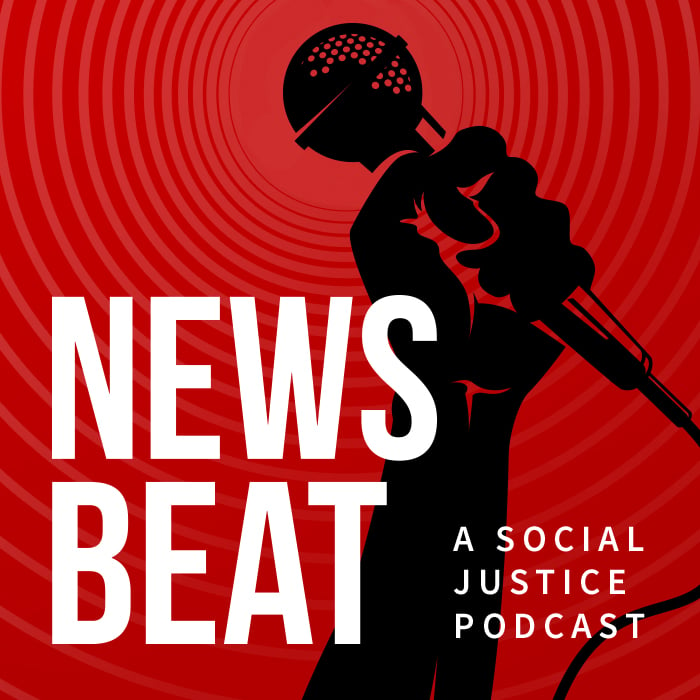The rise in infections in often overcrowded and unsanitary correctional institutions paralleled extreme spikes among the general population, with the disease spreading like wildfire this summer in states that reopened early, defying recommendations from public health experts.
As of this reporting, nearly 900 prisoners have died of the novel coronavirus (COVID-19), according to separate databases compiled by nonprofit The Marshall Project, in partnership with The Associated Press, and the UCLA Law COVID-19 Behind Bars Data Project.
UCLA has tied more 100,000 infections to jails and prisons; The Marshall Project has documented around 95,000 cases.
Listen to the podcast by subscribing to News Beat on your favorite pod app. and sign up for our newsletter.
Overall, COVID-19 has been blamed for more than 170,000 deaths in the America and a whopping 5 million confirmed cases—representing a quarter of worldwide infections, despite the United States accounting for only 4.25 percent of the global population.
While the country’s haphazard response to the virus—including a slapdash reopening effort across various states—has been well documented, the failure to control the disease inside jails and prisons was tragically predictable, and preventable, critics charge. The situation in some parts of the country is as bleak as ever, with jails and prisons accounting for the largest coronavirus “clusters” in America, according to The New York Times.
In Florida, for example, the rate of infection is 482 percent higher than the state overall, according to The Marshall Project’s database. California’s correctional facilities have an infection rate that’s 452 percent greater than the general state population. More than two dozen people have died from the disease in Northern California’s San Quentin State Prison.
"One of the things that I have been extremely troubled by since this pandemic started is the lack of transparency. There's a culture of secrecy that has been allowed to fester in American carceral facilities, and it's antithetical to the democratic project."
- UCLA Professor Sharon Dolovich
At the outset of the pandemic, epidemiologists warned of the potential for uncontrollable spread of the disease among prisoners if proactive measures were ignored. In an interview with News Beat podcast, Homer Venters, the former chief medical officer of New York City’s jails, characterized the disease as a “perilous and looming threat.”
“These places also have chronic understaffing of security staff and health staff,” Venters, president of the nonprofit Community Oriented Correctional Health Services and author of “Life and Death Inside Rikers Island,” told us. “And so many of the ways in which these buildings and places are designed and run promotes the spread of communicable disease.”
Jails Reduced Populations in Early Days of COVID-19 Pandemic
Emily Widra, a research analyst at the Prison Policy Initiative (PPI), a Massachusetts-based nonprofit that studies the criminal justice system, said she was surprised with the initial virus response—in both positive and negative ways.
To mitigate the spread of the disease, jails throughout the country released people in large numbers, at the same time that local police were reducing arrests. For a moment, those actively fighting mass incarceration allowed themselves to imagine a world in which a dramatic reduction in local jails—largely made up of people awaiting trial who can’t afford bail—would be the springboard for more systemic change.
LISTEN: "Why The 2020 Anti-Racism Uprisings Feel Different"
Between March and May, the median reduction in jail inmates was 30 percent, according to PPI. Based on a seven-day rolling average between March 10 and July 22, the jail population inside 475 county facilities fell to about 85,000, from a high of 115,000 in early March.
PPI has identified five county jails with population drops at or greater than 50 percent, including White County Jail in Arkansas, which topped the list at 69 percent.
Municipalities and jail administrators used a variety of tactics to limit jail intake. Instead of resorting to arrests, police issued citations, some jurisdictions eschewed charges for low-level offenses, California set bail at $0 for most misdemeanors and low-level crimes, and jails released people charged with nonviolent offenses or whose pre-existing conditions made them vulnerable to COVID-19.
Bonus Clip: Concern Over Mental Health in Prison Amid COVID-19
“I personally was surprised to see that so many jails had been able to reduce their population so quickly, so effectively,” Widra tells News Beat podcast. “We're talking about jails with thousands of people in them—2,000, all the way down to jails with 20 people in them. Discharge-planning and figuring all that out is a process—especially in a public health crisis—and so that some jails and counties were able to facilitate that, I thought was quite impressive.”
The situation in prisons is a little more complicated. State prisons hold the majority of America’s incarcerated population, with 1.3 million people locked up, according to PPI. As of this reporting, there are about 34,000 less inmates in these facilities than prior to the pandemic, according to the UCLA Law COVID-19 Behind Bars Data Project, which doesn’t include all state prisons.
'A Real Crisis'
In an interview with News Beat podcast, Sharon Dolovich, who is directing the project and also serves as faculty director of the UCLA Law and Prison Policy Program, acknowledged that the data is incomplete because some facilities aren't reporting any infections at all, let alone virus-related fatalities.
"There are 3,200 county jails and the vast majority of them are reporting no information," Dolovich says.
She adds: "One of the things that I have been extremely troubled by since this pandemic started is the lack of transparency. There's a culture of secrecy that has been allowed to fester in American carceral facilities, and it's antithetical to the democratic project."
RELATED: Read our series on mass incarceration and listen to our criminal justice podcast playlist.
Based on the data her team has compiled, people in prisons specifically are infected at a rate that’s 5.5 times higher than the general U.S. population, she says. When accounting for age—inmates on average are younger than people living outside these heavily guarded walls—people are dying at three times the rate.
“So by any measure,” Dolovich says, “that’s a real crisis.”
Dolovich argues that jails were able to release people in greater numbers because there’s so much more “low-hanging fruit”—people being held pre-trial without a conviction, those being held on probation violations, and inmates serving short sentences for low-level offenses.
“On the prison side, there are many fewer mechanisms that are available to prison officials to release people because these are people who are serving sentences that have been imposed by the court, as opposed to in the jail context, where either you haven't even been convicted of anything or you're serving a short time that was imposed on you by a local municipal court,” she says, adding, “Prison officials have much less scope for release.”
One arsenal in the toolkit of governors nationwide is the power to grant early release to prisoners, including through commutations—a process advocates encouraged officials to leverage as the pandemic gripped the country.
Critics charge that governors have done very little in this regard. In an op-ed in The Appeal in July, San Francisco District Attorney Chesa Boudin and Miriam Krinsky, executive director of the nonprofit Fair and Just Prosecution, said the chief executives of states “utterly failed to protect their constituents.”
What is Dolovich's read on the gubernatorial response?
“Unfortunately, you haven't really seen much courage on that front,” she says.
Related: San Francisco DA Chesa Boudin talks about COVID-19 and reforming the criminal justice system from the inside
However, she did note that some governors have released people who committed minor offenses, and cited California’s plan to reduce the state’s prison system, which is still more than 100 percent over capacity, by 8,000 in the coming weeks. That’s on top of the accelerated release of 3,500 people cleared for parole.
Among those slated for release are mostly elderly prisoners and those with medical conditions that make them most vulnerable to COVID-19, including people benefiting from an expansion of good time credits, she says.
“My own view is it’s not nearly enough,” Dolovich says of mitigation efforts nationwide.
As of mid-August, roughly 98,000 people have been released from jails and prisons due to coronavirus concerns, according to the UCLA database.
However, the rate of release from jails, in particular, has slowed since the end of April, the Prison Policy Initiative reported in August.
“Seventy-one percent of the 668 jails we’ve been tracking saw population increases from May 1st to July 22nd, and 84 jails had more people incarcerated on July 22nd than they did in March,” states the organization.
Prisons have yet to see an uptick in intakes since July, which Widra attributes to the more modest reductions since the pandemic hit.
Listen to the podcast by subscribing to News Beat on your favorite pod app.
According to figures collected by The Marshall Project, infections temporarily fell in early June but quickly spiked in the subsequent weeks, eventually rising to 8,000 new infections in August.
“These prison population changes have occurred, and yet they're just not nearly enough to actually protect people,” Widra says.
Prisons Emerge as Top COVID-19 ‘Clusters’
With more than 9,500 infections and 55 deaths, California’s prison system is among the hardest hit in the nation.
It’s received increased scrutiny in recent weeks amid an outbreak in the notorious San Quentin State Prison, which is responsible for about a quarter of the system’s COVID-19 infections and almost half its deaths.
“The response of the state in terms of the situation in prisons has been the exact opposite of what we want it to be, in that the state caused the outbreak at San Quentin,” says Danielle Harris, managing attorney of the San Francisco Public Defender’s Integrity Unit.
In May, the state transferred 131 men from the already impacted California Institution for Men in Chino to San Quentin without properly testing them for the virus, sparking the outbreak that only recently has shown signs of slowing.
“Before that happened,” Harris says, “San Quentin had no cases of COVID-19.”
Harris echoes many of the criticisms that public health officials and decarceration advocates have aired throughout the pandemic: Social distancing is nearly impossible in carceral settings due to overcrowding, most facilities are unsanitary and health services are insufficient.
“The cells in San Quentin, for example, are 4 foot by 9 foot cells housing two people,” Harris says. “You can touch the sides of the cell with your arms even if you're not a particularly big person. And then there's all kinds of issues with ventilation and open bars. They call that an open cell block setting, and so the rules that we are all being constantly reminded to follow are impossible in a jail and prison setting.”
As of this publication, San Quentin was the top COVID-19 “cluster” in the country, according to the Times analysis. Eighteen of the top 20 are correctional centers, underscoring the tremendous level of spread inside facilities housing inmates.
The large-scale infections impacting imprisoned people across the country is the consequence of a uniquely American experience: mass incarceration. The United States has the highest incarceration rate in the world, with 2.2 million people currently locked up. Making matters worse, the percentage of people 55 or older in prisons has skyrocketed since 1999, the result of punitive sentencing laws adopted amid the racist war on drugs and the tough-on-crime era of American politics. Older populations are more susceptible to the worse effects of the novel coronavirus—which could be catastrophic for older inmates who experience aging sooner than the general population.
Trying to ascertain who is dying inside correctional facilities—and potentially draw conclusions about who’s most at risk—has been difficult, Dolovich says. Although state department of corrections are officially reporting death counts, “They’re not willingly giving up information about which people are dying,” she notes, adding that state agencies are invoking health privacy laws to prevent researchers and journalists from accessing records.
“People have to go through the families and next of kin because they're legally the ones that have control over the medical records,” Dolovich says.
Despite the early work to reduce these populations, advocates continue to argue for a more aggressive response.
In June, PPI and the American Civil Liberties Union (ACLU) released its evaluation of every state’s response to the pandemic inside jails and prisons. The verdict: Most states failed in its efforts to mitigate the spread of the virus, with only a few receiving a “D-”—the highest mark awarded.
“The results are clear: Despite all of the information, voices calling for action, and the obvious need, state responses ranged from disorganized or ineffective, at best, to callously nonexistent at worst,” researchers wrote. “Even using data from criminal justice system agencies—that is, even using states’ own versions of this story—it is clear that no state has done enough and that all states failed to implement a cohesive, system-wide response.”
As for the prison currently suffering the largest outbreak, people inside San Quentin are “terrified” about what’s to come, says Harris, of the San Francisco Public Defender’s Office.
“If they didn't already feel before like society had forgotten them, now that [they] feel that their lives are every day in danger, they sure feel that way now,” she says.









